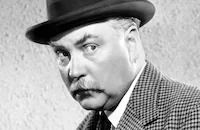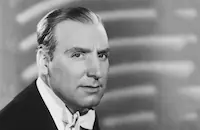Terror by Night

Brief Synopsis
Cast & Crew
Roy William Neill
Basil Rathbone
Nigel Bruce
Alan Mowbray
Dennis Hoey
Renee Godfrey
Film Details
Technical Specs

Synopsis
In London, Vivian Vedder visits coffin makers Mock and Son to verify the completion of a coffin for her mother's body, which she is transporting to Scotland that evening on the Scotch Express. That night at Victoria Station, detective Sherlock Holmes meets Ronald Carstairs, who, with his mother, Lady Margaret, has hired Holmes to protect their most valued possession, the infamous Star of Rhodesia diamond, during their return journey to Edinburgh on the Express. Ronald admits that Holmes is correct in assuming an attempt was made to steal the bauble during his and Lady Margaret's visit to London. While waiting for his partner, Dr. John Watson, Holmes observes the arrival of Scotland Yard's Inspector Lestrade, who claims to be going north for a fishing vacation. Holmes quickly deduces that Lestrade is actually making the trip as official protection for the renowned gem. As the Express pulls out of the station, the late-arriving Watson just manages to board the train with a companion, Major Duncan-Bleek, whom the doctor introduces to Holmes as a member of his club. After the train is on its way, Holmes and Watson examine the 423- carat stone with Ronald and Lady Margaret. Later in the dining car, as Lady Margaret waits for Ronald, Holmes finds an anonymous card on his plate with a written warning. Meanwhile, Lestrade, in his compartment next to the Carstairs', hears a strange noise and upon investigating with Holmes, discovers Ronald's dead body and the empty jewelbox. Watson finds no marks on the body except for a small scratch, and Holmes suspects that Ronald was poisoned. Lestrade and Holmes begin questioning the passengers and note that Lady Margaret is more concerned over the theft of her stone than the murder of her son. Upon discovering that Vivian is in mourning, Lestrade and Holmes demure from interrogating her and turn to questioning Professor Kilbane, a mathematics instructor, who resents their inquiries. When Lady Margaret is discovered secretly attempting to enter her restricted compartment, Watson and Duncan-Bleek suspect that she has arranged to have the jewel stolen to collect the insurance. Holmes, however, postulates that the crime reflects the interests of the cunning Colonel Sebastian Moran, a cohort of Moriarty, Holmes's criminal archrival. While Lestrade questions Lady Margaret further, Holmes begins following Kilbane toward the luggage compartment. The professor abruptly disappears and when Holmes comes across an open passenger door, he is suddenly pushed through the door which is then locked behind him. Holmes narrowly escapes being hit by an oncoming express, then breaks the glass in the door to get safely back inside. Holmes and Watson proceed to the luggage compartment, where they inspect the Vedder coffin, which is far too large for the lightweight body inside. After more exploration, Holmes locates a secret compartment under the body, large enough for a small adult, which leads the detective to the conclusion that two people are involved in the crime. When Holmes and Lestrade question Vivian, she admits that a man paid her to transport the coffin. Watson and Duncan-Bleek join the group and Holmes astounds them all by revealing the Star has not been stolen, but was in his possesion the entire time as he used the opportunity of examining it earlier to switch the genuine stone with an imitation. Lestrade quickly takes possession of the authentic jewel. Later, when Holmes and Watson return to the luggage compartment, they find the porter has been murdered by a tiny poisonous dart made out of a dissolving substance. Meanwhile, unknown to the others, Duncan-Bleek is joined in his compartment by Sands, a rough street criminal who came aboard via the coffin's hidden compartment and is the major's cohort in the crime. Duncan-Bleek informs Sands their stone is a fake and sends him to get the gem from Lestrade, but after Sands knocks out the investigator, Duncan-Bleek kills Star using an airgun with the poisonous darts and takes the Star. Holmes and Lestrade discover Sands's body just as the train makes an unexpected stop in a small village to pick up several policemen led by Inspector McDonald of the Scottish police, who have come aboard to take over the investigation. Lestrade, still groggy from being beaten, asks Holmes and Watson to deal with the inspector. To Watson's amazement, Holmes informs McDonald that Duncan-Bleek is really Sebastian Moran, but when McDonald arrests Duncan-Bleek and the police lead him away, the lights on the train are extinguished and a scuffle ensues. Holmes recaptures Duncan-Bleek by throwing a coat over him in the darkness, and the officers hustle away their prisoner. As the train departs, Holmes reveals that McDonald and his men were imposters in league with Duncan-Bleek, whom Holmes had secretly handcuffed and hidden under the table during the scuffle. McDonald's prisoner is actually Lestrade, whose face was obscured by the coat. With the capture of the thieves, Holmes then admits that he has pocketed the valuable Star of Rhodesia.

Director
Roy William Neill
Cast

Basil Rathbone

Nigel Bruce

Alan Mowbray
Dennis Hoey

Renee Godfrey
Frederic Worlock
Mary Forbes
Skelton Knaggs

Billy Bevan
Geoffrey Steele
Leyland Hodgson
Boyd Davis
Janet Murdoch
Gerald Hamer

Harry Cording
Charles Knight
Gilbert Allen
Colin Kenny
Tom Pilkington
Bobby Wissler
Crew
Howard Benedict
Jack A. Bolger Jr.
Bernard B. Brown
Carmen Dirigo
Russell A. Gausman
Maury Gertsman
Saul A. Goodkind
John B. Goodman
Abraham Grossman
Frank Gruber
Raymond Kessler
Carl Lawrence
Roy William Neill
Jack P. Pierce
Milton Rosen
Melville Shyer
Vera West

Film Details
Technical Specs

Articles
Sherlock Holmes in Terror by Night
Terror by Night (1946) is thought by many fans of Rathbone's Sherlock Holmes films to be one of the best of the Universal series. Set on a train, it's a quintessential old-school whodunit, with all the passengers open to suspicion and each one looking guiltier than the last. The plot involves an invaluable diamond - The Star of Rhodesia - cursed, of course ("all who possessed it came to sudden and violent deaths"), and carried aboard the train by its owner, Lady Margaret Carstairs (Mary Forbes) and her son, Roland (Geoffrey Steele). Holmes and Watson have been engaged by the Carstairs to guard the diamond, but Inspector Lestrade (Dennis Hoey) "happens" to be aboard too, ostensibly for a fishing trip. Before long (and there are only 60 minutes to the film, so none to spare), the diamond is indeed stolen (or is it?) and the murders begin piling up, several committed with a poisonous dart - the killer's calling card.
Terror by Night features a great cast of character actors, including some series regulars. Hoey makes his last appearance here as Lestrade. Alan Mowbray, who plays Maj. Duncan-Bleek, played Lestrade to Reginald Owen's Holmes in the 1933 production of A Study in Scarlet. Frederick Worlock, who appears as the perfectly crotchety Prof. Kilbane was in a number of Holmes' films, as was Gerald Hamer, who makes his last series appearance, here as a small-time thief.
The film was shot in the final months of 1945, and the script for the next Holmes film, Dressed to Kill (1946) was ready to go. But Rathbone had already made the decision to part company with the character to whom he felt his career had become handcuffed. In 1946 his long-term contracts with MGM (who had loaned him to Universal for the Holmes films) and MCA (for whom he did the radio version of the series), were set to expire. Dressed to Kill would then become the last time Rathbone would play Holmes, and some believe the light at the end of that tunnel is what made his performance in Terror by Night so energetic. And was there ever a more suave Holmes? In many ways he was a precursor to James Bond in his unflappable style: after fighting for his life on the outside of the train in one scene, he smoothes his hair as he enters his compartment and tells Watson he had just been "observing the landscape." Equally impressive is the tight direction of Roy William Neill, which had a much more energetic pace than several of the preceding Holmes' films he helmed, an opinion shared by Rathbone and most critics.
Released from his contracts, Rathbone went back to New York and the stage in 1946. The next year, he won a Tony Award for his portrayal of Dr. Swoper in the Broadway play The Heiress but was reportedly crushed when he was not asked to reprise the role for the film version. Ironically, by 1951, Rathbone was willing to play Holmes again and did so in a play written by his wife, Ouida. He appeared on and off Broadway throughout the '50s and in a one-man show titled An Evening With Basil Rathbone. He continued to appear in television series and films until his death in 1967.
Producer: Roy William Neill, Howard Benedict
Director: Roy William Neill
Screenplay: Frank Gruber, Arthur Conan Doyle (story)
Cinematography: Maury Gertsman
Film Editing: Saul A. Goodkind
Art Direction: John B. Goodman, Abraham Grossman
Music: Hans J. Salter
Cast: Basil Rathbone (Sherlock Holmes), Nigel Bruce (Dr. John H. Watson), Alan Mowbray (Maj. Duncan-Bleek/Col. Sebastian Moran), Dennis Hoey (Inspector Lestrade), Renee Godfrey (Vivian Vedder), Mary Forbes (Margaret Carstairs).
BW-60m.
by Emily Soares

Sherlock Holmes in Terror by Night
Quotes
Trivia
Notes
In Terror By Night actor Dennis Hoey returned to the role of "Inspector Lestrade" after not appearing in two previous Sherlock Holmes films. This was his last appearance in the series. Although the onscreen credits say "adapted from a story by Sir Arthur Conan Doyle," the source has not been identified and it is possible that only the characters were used for this film. For additional information on the Sherlock Holmes series and other films featuring the Arthur Conan Doyle characters, please consult the Series Index and see the entry above for Sherlock Holmes and the Voice of Terror and the entries for Sherlock Holmes and The Hound of the Baskervilles in AFI Catalog of Feature Films, 1931-40; F3.4020 and F3.2009.















